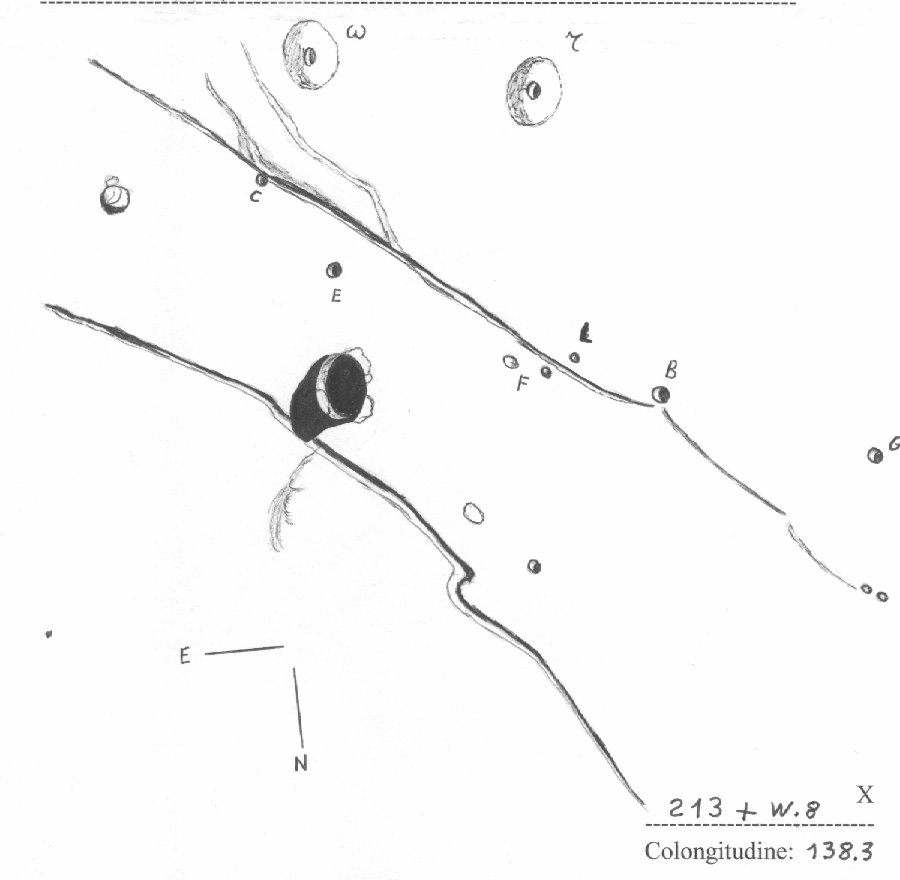
Massimo Cicognani drawing carried out on 18 august 2000 at 22:30 UT
Seeing II- III (Antoniadi scale) refractor 12 cm f/6.7 ( 213x and yellow filter W 8 ). Domes Cauchy omega and Tau . Observation carried out at sunset (colongitude 138).
R. Lena, M. Cicognani, Pg.
Salimbeni, A. Bares, D. DelValle, M. Higashida, R. Porta
.
In previous works we reported
some considerations about volcanism and tettonic processes on the Moon.
As for domes research the altitude of the sun above the lunar surface is
one of the governing factors in the observation of the rilles.
The region of Cauchy is very
complex and holds a great deal of opportunity for the amateur with any
telescope to observe the diversity of geological features. We are
documenting some structures in more detail .
Across the north-eastern plains
of the Mare Tranquillitatis lie two near-parallel cracks in the Moon's
surface, both more than 200 km long. Rupes and Rima Cauchy (the Cauchy
scarp and rille) are named after the bright 12 km diameter impact crater
Cauchy that lies between them. Both features were formed after the massive
lava flows that formed the maria had cooled and had begun to settle,
and they were caused by a localised stretching apart of the lunar crust.
In sunset Rupes Cauchy stood out as a bright line while it casts
a prominent shadow at sunrise.
These images and drawings
are only a representative selection of
these observations and will give a basis for future comparisons.
Our observation are as follows:

Massimo Cicognani drawing
carried out on 18 august 2000 at 22:30 UT
Seeing II- III (Antoniadi scale)
refractor 12 cm f/6.7 ( 213x and yellow filter W 8 ).
Domes Cauchy omega and Tau . Observation carried out at sunset (colongitude
138).
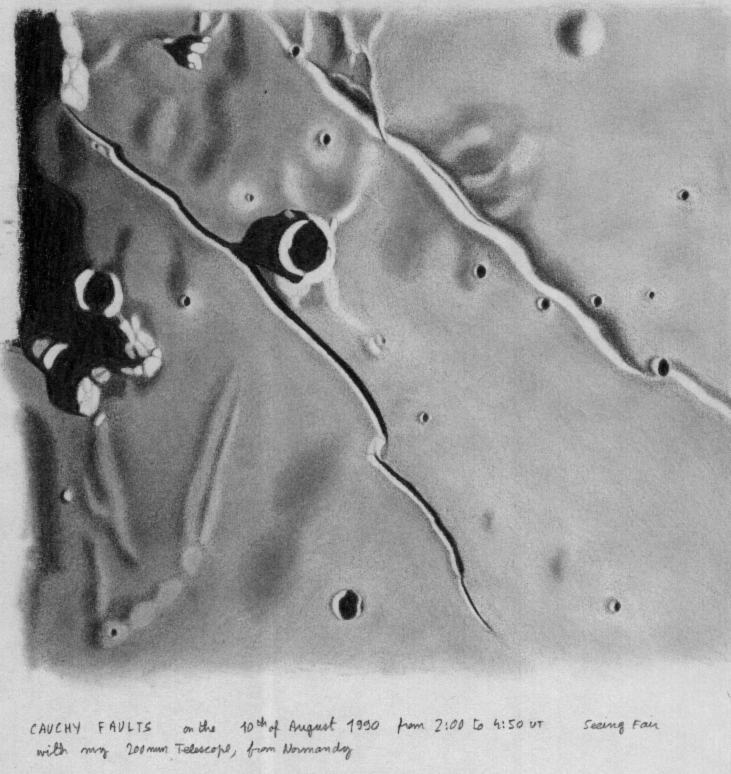
N. Biver observation carried out on 10 august 1990 from 2:00 to 4:50 UT Newton 200 mm
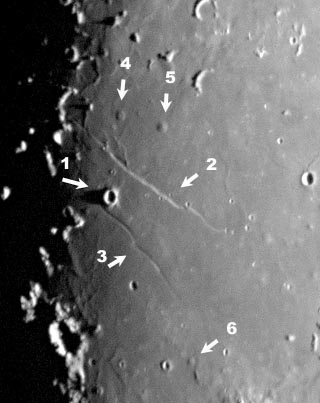
Morio Higashida CCD image of the Cauchy region
(Newton 200 mms f/6).
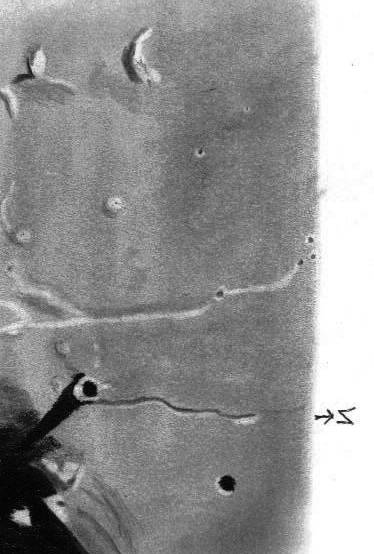
Daniel Del Valle. Observation carried out (sunset)
on 3 january 2002 at 4:19 UT. SCT 20 cm f/10 270x (seeing III Antoniadi
).
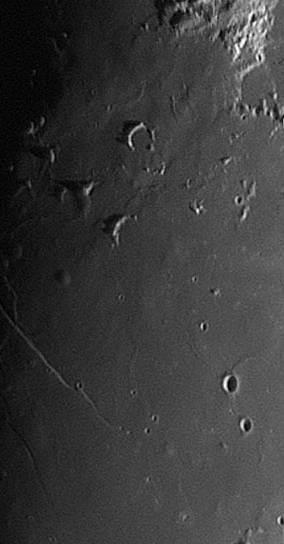
A. Bares a CCD image of the region.
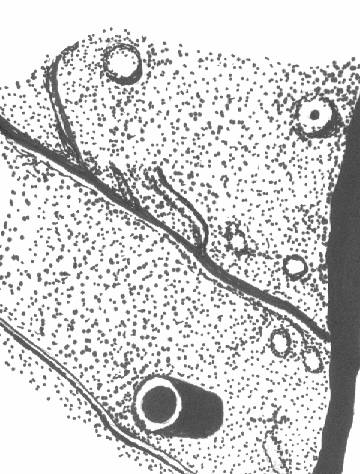
Raffaello Lena on december 10 2001 at 17:30 UT
Refractor 10 cm f/15 at 250x.
Seeing II Antoniadi.
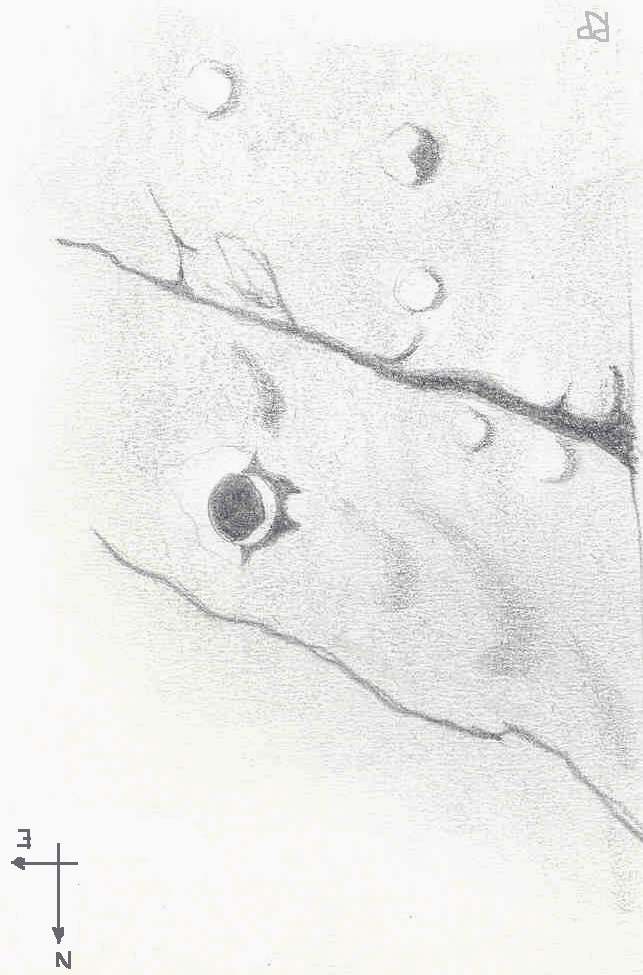
Roberto Porta drawing
carried out on 6 June, 2000 at 19:50 UT
Seeing III-IV (Antoniadi scale)
SCT 200mms f/10 ( 180x and 222x yellow filter W 8 ).
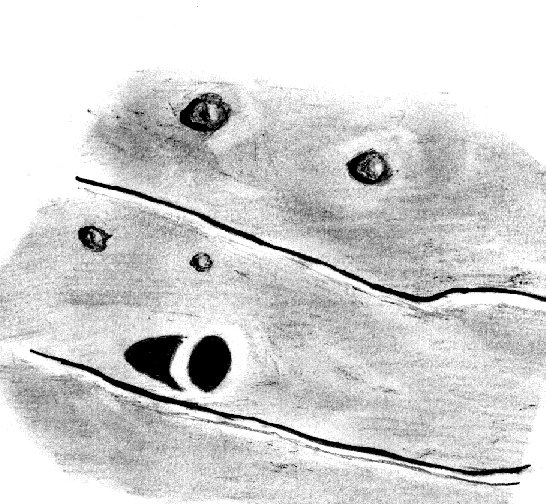
Raffaello lena drawing
carried out on 5 april 1999 at 1:00 UT
Seeing III (Antoniadi scale)
SCT 250 mms f/10 ( 200x and yellow filter W 8 ). Cauchy and
domes at sunset (colongitude 136.0°).
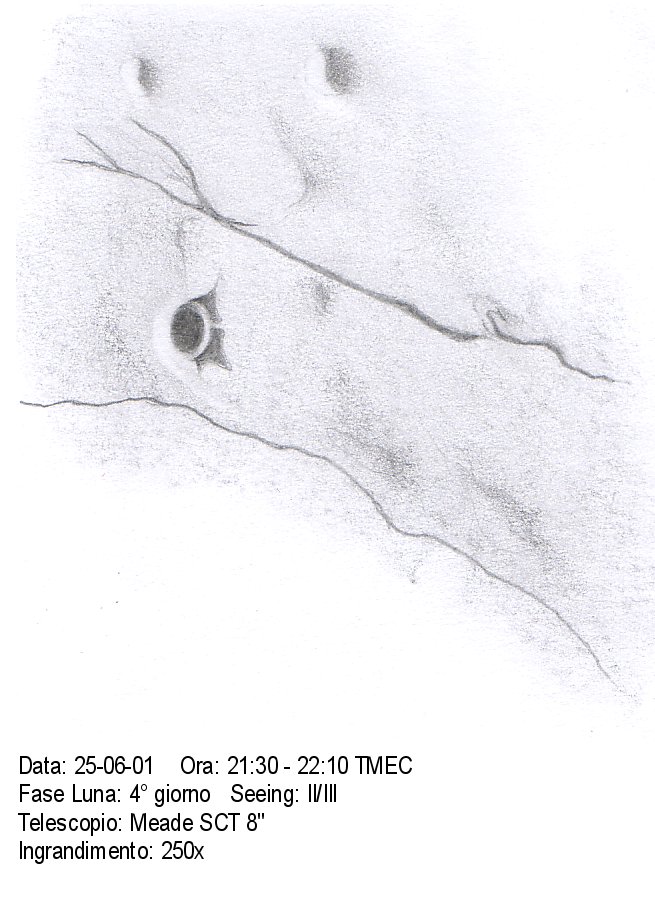
Roberto Porta drawing
carried out on 25 June, 2001 at 19:30-20:10 UT
Conclusion
The ALPO list reports several domes
in the Cauchy region:
38*30' 05*10' .620 .090 Cauchy
38*22' 02*35' .620 .045 Cauchy-+610,+042 (25x22)
38*90' 09*67' .619 -,168 Gutenberg BAA small, round
38*49' -09*37 .618 -.167 Gutenberg 13 BAA has 2 craters at summit
38*12' 03*54' .617 .068 Cauchy 16
41*12' -20*44' .616 -.354 Santbech 9
38*19' 07*14' .615 .126 Cauchy 9.6 BAA steep, round dome
38*03' 03*44' .615 .065 Cauchy 25 BAA (35kms) low, irregular
40*45' -20*07' .613 -.344 Santbech 4 BAA small, round (east of
crater
S)
40*57' -20*59' .612 -.358 Santbech 9
37*38' 02*24' .610 .042 Cauchy 30 BAA - low & ill-defined
38*12' 09*58' .609 .173 Cauchy
41*12' -22*24' .609 -.381 Santbech 4.1 BAA small, round. To east
of
crater S
41*00' -22*05' .608 -.376 Santbech 9 68 37*47' 08*24'
.606 .146
Cauchy
37*38' 07*07' .606 .124 Cauchy NDF
40*41' -22*20' .603 -.380 Santbech 5.5 BAA - steep, hemispherical
37*43' 10*12' .602 .177 Cauchy 2 72 37*19' 06*47'
.602 .118 Cauchy
12x14
36*56' 03*09' .600 .055 Cauchy .7 BAA low, ill-defined-see +551,+07
37*32' 10*33' .599 .183 Cauchy
39*38' -20*07' .599 -.344 Santbech 9.6
37*05' 08*41' .596 .151 Cauchy
36*35' 03*09' .595 .055 Cauchy-see +571,+075 30
38*09' 15*58' .594 .275 Maraldi 1
36*50' 07*42' .594 .134 Cauchy 2(8)
39*28' 21*06' .593 .360 Maraldi 6x7
38*46' 18*43' .593 .321 Maraldi
38*44' 18*36' .593 .319 Maraldi
36*44' 07*32' .593 .131 Cauchy 10.3 BAA - steep, round dome
36*31' 05*55' .592 .103 Cauchy 3
38*26' 18*54' .588 .324 Maraldi
39*00' 21*21' .586 .364 Maraldi 2
35*58' 06*09' .584 .107 Cauchy
Our observations are in progress.
Acknowledgements
We acknowledge the contribution to the observations by
N. Biver for furnishing the drawing.